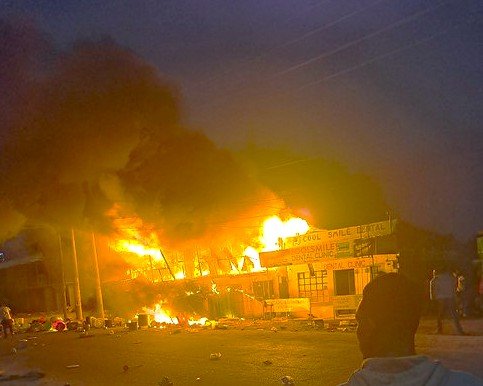KITENGELA, KENYA. Another devastating fire razed parts of Kitengela town, gutting houses and shops and people forced to begin anew. Preliminary findings point to poor electrical connections as the likely cause picking up a trend not only in Kitengela but in many other rapidly growing towns in Kenya.
This latest conflagration, which devastated a section of Kitengela on July 24, 2025, is another cruel reminder that the town is vulnerable to inferno disasters. Initial reports put several houses in a sad state of destruction, though no fatalities had been reported at the time of writing. Authorities further comment that the fire was most likely to have originated in one of the densely grouped rental flats and readily spread due to poor electrical installations and the absence of immediate firefighting efforts.
The supposed cause fouled wiring is consistent with a 2025 U.S. Fire Administration report stating that over 24,000 electrical house fires worldwide occur annually. The report specifically cites compromised or deteriorating wire insulation as among the leading sources of ignition.
In Kenya, where unregulated electrical connections and informal housing are the norm, the risk of electrical fires is exacerbated. Landlords in most instances, especially in high-density low-income cities like some sections of Kitengela, prefer to use substandard materials or circumvent safety devices to save on costs.
“We have been complaining a lot to the county about illegal wiring and poor fire preparedness,” declared David Mutuku, a Kitengela tenant whose shop was destroyed in the fire. “But nothing ever gets done until something goes wrong.”
This isn’t Kitengela’s first brush with fire tragedy nor its second. Less than a year ago, a separate blaze caused an estimated Ksh20 million in property damage, displacing dozens of families. Just months before that, in October 2024, another fire gutted a section of a commercial estate, forcing business closures and prompting promises of better emergency response systems.
But little has been achieved. Despite the fact that such fires are common, Kitengela remains woefully unprepared. The town lacks an appropriate fire station, and response times to emergencies are outrageously sluggish. During the most recent fire, one saw that it took over 45 minutes for fire engines from adjacent Kajiado County Fire Department to arrive by which time destruction was already widespread.
“We rely on Nairobi or Athi River to come and save us. But by the time they come, the fire has already burnt everything,” a local chief who did not want to be named explained.
Kitengela has seen its population experience rapid growth over the last few years, from a secluded town to a thriving peri-urban center. Unfortunately, infrastructure development has not been as rapid as population growth. This applies to essential sectors like firefighting, urban planning, and building inspection enforcement.
Most of the buildings in the town informal rentals and mixed-use buildings particularly are constructed without paying attention to building codes or safety requirements. Overloading the power is common and shared circuits frequently operate poorly under risky conditions.
Compounding the affliction is an inadequacy of public information about fire prevention. Fire extinguishers, smoke detectors, and emergency exits are the exception rather than the norm even in businesses.
The tragedy can only be an eye-opener for national and county governments. Safety from fire is not a choice it is an inherent human right tied to citizens’ health and security.
Some quick action Kitengela and similar towns must undertake:
Establish a fire station in Kitengela to drastically reduce response times.
Enforce stricter building codes with rigorous safety inspections on electrical infrastructure.
Launch fire prevention and safety community education campaigns.
Subsidize or help install simple safety equipment like alarms and extinguishers, especially in rental houses.
Work together with Kenya Power and REA (Rural Electrification Authority) to dismantle illegal and unsafe electrical connections.
“I lost everything my clothes, my ID, my child’s school books,” Mercy Wanjiku, a 28 year old mother of two whose home was one of the ones set afire. “All I could do was pick up my babies and go. There was no alarm, no help.”
For Mercy and those like her, fire is not just a threat it’s a constant trauma, compounded by indifference and neglect.
Kitengela’s fire disaster is a miniature of a larger issue afflicting Kenya’s growing cities: untrammeled expansion without planning for safety. Until enormous investment is put into fire infrastructure, education and enforcement, these tragedies will keep happening and every single one of them will bring another wave of loss, bereavement, and speculation about what could have been prevented.
It’s time for Kitengela to respond no longer and prepare because the cost of delay is paid in livelihoods and lives.
Faulty Wiring Sparks New Kitengela Fire as Residents Demand Protection




Kinonavigator ist eine Anlaufstelle für Cineasten, die kuratierte Auswahl ohne Umstände wollen.
Was bietet Kinonavigator?
10 Filme pro Thema: Von Zeitreise-Abenteuern bis hin zu Filmen für Regentage.
Wo streamen?: Direkte Links zu kostenlosen Plattformen.
Trailer & Clips: Hol dir einen Vorgeschmack.
Filmstills: Perfekt für Social-Media-Posts.
Keine Anmeldung — einfach Kino unkompliziert.
Entdecken Sie einzigartige Genres auf https://my.archdaily.com/us/@kinoradar
Kinonavigator ist eine Anlaufstelle für Filmfans, die frische Empfehlungen wollen.
Was bietet Kinonavigator?
10 Filme pro Thema: Von schwarzen Komödien bis hin zu Filmen für Regentage.
Wo streamen?: Direkte Links zu Prime Video.
Making-of-Material: Hol dir einen Vorgeschmack.
Filmstills: Perfekt für Hintergrundbilder.
Keine Spoiler — einfach Kino unkompliziert.
Entdecken Sie einzigartige Genres auf https://kinoradar.booth.pm/